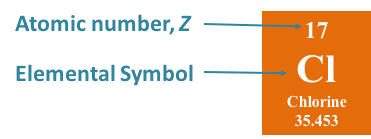The elements on the periodic table are ordered by atomic number. The atomic number indicates the identity of an atom. The atomic number is represented with a capital Z. The atomic number, Z, is equal to the number of protons in a neutral atom. This also means the number of electrons in a neutral atom can be determined from Z. Recall, in a neutral atom, the number of electrons and protons are equal. In the figure below, we see that chlorine has an atomic number of 17. There are 17 protons and 17 electrons in a chlorine atom.
Note that Z does not give any information about the number of neutrons in the atomic nucleus. The mass number, A, is the sum of the protons and the neutrons in the nucleus of an atom. The mass number, A, is always a whole number and never in decimal form. To determine the number of neutrons in an atom, subtract Z from A.
If A = 37 for chlorine, chlorine would have 37 – 17 = 20 neutrons in its nucleus. The isotopic symbol for Chlorine-37 is shown below.
\( ^{37}_{17}Cl \)
The mass number, A, is written as a superscript in the upper left hand corner of the atomic symbol, and the atomic number, Z, is written as a subscript in the lower left hand corner. The chlorine atom has 17 protons, 17 electrons, and 20 neutrons. The Chlorine-35 atom has 17 protons, 17 electrons, and (35 – 17) 18 neutrons. The isotopic symbol is
\( ^{35}_{17}Cl \)
Both Cl-37 and Cl-35 are isotopes–they have the same atomic number, Z, but different mass numbers, A. They only differ in the number of neutrons. Most naturally occurring elements are a mixture of isotopes. Hydrogen has three stable isotopes:
deuterium \( ^{2}_{1}H \)
tritium \( ^{3}_{1}H \)
Protium, deuterium, and tritium all have the same number of protons, but differ in the number of neutrons. A sample of hydrogen will contain 99.985% protium, 0.015% deuterium, and a trace amount of tritium. A sample of oxygen contains 99.759% Oxygen-16, 0.037% Oxygen-17, and 0.204% Oxygen-18. The percent abundance of Oxygen-16 is 99.759% and the fractional abundance is 0.99759. The percent abundance of deuterium is 0.015% and the fractional abundance is 0.00015. To calculate the fractional abundance, divide the percent abundance by 100.
The atomic mass of an element is the weighted average mass of the element’s naturally occurring isotopes. On earth, carbon is a mixture of two isotopes: \( ^{12}_{6}C \) and \( ^{13}_{ 6}C \). Carbon-12 has an isotopic mass of 12 amu with a percent abundance of 98.89% and Carbon-13 has an isotopic mass of 13.0034 amu with a percent abundance of 1.11%. An amu is an atomic mass unit and can also be represented by u. One atomic mass unit is equal to 1/12 of a carbon-12 atom. One amu has a value of 1.660 x 10-24 g–the same as a proton and/or neutron.
Two things are required to calculate the average weighted atomic mass: the mass and the fractional abundance of each naturally occurring isotope. Recall, the fractional abundance is the percent abundance divided by 100. The weighted average atomic mass is calculated by multiplying each isotopic mass by its fractional abundance and then summing the values.
For carbon, the weighted average atomic mass is calculated as:
As another example, chlorine has two naturally occurring isotopes: \( ^{35}_{17}Cl \) and \( ^{37}_{17}Cl \). Chlorine-35 has a mass of 34.969 amu and a percent abundance of 75.76% and chlorine-37 has an isotopic mass of 36.966 amu with a percent abundance of 24.24%. The weighted average atomic mass of chlorine is:
Atomic mass will be discussed further in the next study guide, Moles, Entities, and Mass.
Worksheet: Atomic Structure and Atomic Mass
Worksheet: Isotopes and Average Weighted Atomic Mass
You might be interested in watching the following videos before attempting the exercises.
Exercises
Exercise 1. How many protons, neutrons, and electrons are in an atom of \( ^{15}_{7}X \)? What is the identity of the element X?
Exercise 2. How many protons, neutrons, and electrons are in 16O, 17O, and 18O?
Exercise 3. Element X is composed of 4 naturally occurring isotopes: X-32, X-33, X-34, and X-36. Calculate the average weighted atomic mass of element X. Use the data in the table below for the calculation. Give the possible identity of element X.
Exercise 4. Magnesium is composed of 3 naturally occurring isotopes: Mg-24 with an isotopic mass of 23.985 amu and 78.99% abundance; Mg-25 with an isotopic mass of 24.986 amu and 10.00% abundance; and a third isotope with 11.01% abundance. The atomic mass of magnesium is 24.3059 amu. What is the mass of the third isotope?


